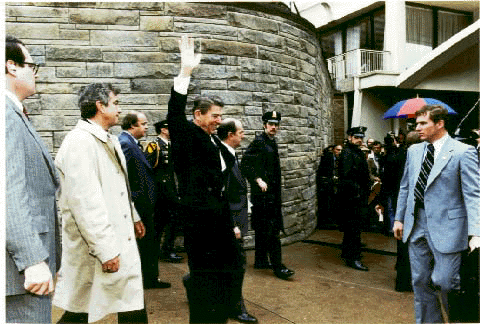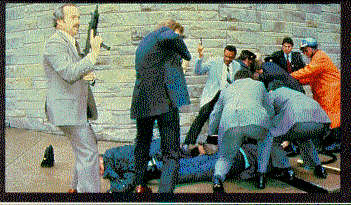The Day Started Like Any Other
On the morning of March 30, 1981, John Hinckley started his day like many other Americans--he ate breakfast at McDonald's. He finished eating, returned to his hotel room, bought a newspaper, and began reading the articles. One article in particular caught his attention--President Ronald Reagan would be making a luncheon speech at the Washington Hilton later that afternoon. He took a shower and debated on whether to go to New Haven, Connecticut to see Jodie Foster or go to the Hilton.
After debating awhile, he decided to check out the Hilton and proceeded to draft a letter to Jodie Foster, put on a coat, grabbed a .22 caliber pistol, grabbed a handful of bullets, and went to the Hilton. In the meantime, President Reagan had just finished a speech to 3,500 AFL-CIO delegates at the Washington Hilton.
At approximately 2:25p.m., the president and his advisors stepped out into the rain and walked towards the limousine waiting 25 feet from the hotel's entrance. The President responded to calls of "Mr. President" from the crowd, and waved first with one hand, then the other.

The Shooting Spree Begins
According to Hinckley, "I didn't even see him at first, I just saw Secret Service and police . . . . Then I saw him. He was . . . waving across the street first, then he turned toward us again, or was in the motion of turning. I never let him get all the way around . . . . That's when I pulled out the gun and started firing."
With dozens of media members and curious onlookers present, Hinckley fired off six shots in less than three seconds. The first bullet slammed into Press Secretary James Brady's head; exploding on impact. He fell immediately to the ground, bleeding profusely from the devastator bullet lodged in his brain.
Hinckley fired again, this time making hitting Washington Police Officer Thomas Delahanty in the neck. He, too, fell instantly to the ground. The third bullet whizzed through the crowd, missing its human targets by inches, and smashed into a building across the street.
At the sound of the shots, Secret Service agent Timothy McCarthy leapt between the president and the shots, arms spread wide providing a "human shield." In mid-leap, he shielded the President from the fourth bullet which was heading straight for the President's head. McCarthy was hit directly in the abdomen and fell immediately to the ground. Hinckley fired again; this time shattering the windshield on the presidential limousine.
Now frantic, another agent shoved President Reagan toward the waiting limousine, but it was too late; the last bullet grazed the limo's rear fender, richocheted up through the open door, and hit the President directly in the left armpit. Hinckley had succeeded in his efforts to put a bullet in the President of the United States. The presidential limousine sped from the scene and left a scene of devastation behind; including the shooter, John Hinckley.
The first to reach Hinckley was a civilian who tackled him from behind as the last bullet was fired. Next to reach him was a Special Agent, diving on him as he continued to pull the trigger on an empty gun. The agent was quickly followed by the arrival of two police officers who handcuffed him. He was further surrounded by even more officers and federal agents. The devastation was finally over, but the damage was done. Four men, including the President of the United States, were wounded. One man in particular, James Brady, appeared to be mortally wounded.
Hinckley is Booked and Charged
Immediately after the shooting, Hinckley was taken and booked at the Metropolitan Police Department in Washington D.C. on thirteen criminal counts including knowingly and intentionally attempting to kill the president and assaulting a police officer. At first, he denied any knowledge of the presidential shooting.
His attitude soon changed and he began asking officers if the media had videotaped the events and whether the video's showing would pre-empt the Academy Awards that evening. Dr. William Brownley was summoned and performed a physical exam and noted no abnormalities. By all accounts, he appeared to be quite aware of what he had done and its significance.
Law enforcement agencies moved quickly to identify the man apprehended. The suspect was interviewed by the FBI, Metro Police Departments, and Secret Service. His wallet and personal belongings were also searched. Shortly after 3:00p.m., less than one hour after the shooting, he was positively identified as John W. Hinckley, Jr..
Wasting no time, law enforcement officials moved swiftly and criminal complaints were sworn against Hinckley for attempting to kill the president and assaulting police officers around 11:00p.m.. Immediately after learning of their son's involvement in the shooting, John's father hired Vincent Fuller, top of his class at Georgetown Law School and Senior Partner of the law firm Williams & Connolly to defend him.

